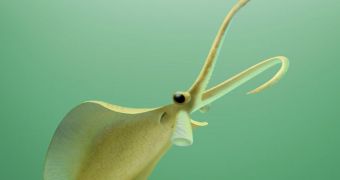Scientists have always thought it was funny how a single creature could by itself force science to reconsider established knowledge. In the most recent such instance, investigators determined that the small fossil called Nectocaris pteryx – formerly classified as a shrimp with a chordate tail – was none of the above. In a new investigation, it was determined that the creature was not an arthropod, as shrimps were, and neither a chordate, as vertebrates and some of their closest relatives were. The creature is in turn a mollusk, the researchers say, and this data may prompt a reshaping of one of the branches in the evolutionary tree of life, LiveScience reports.
In a paper detailing the findings, published in the May 27 issue of the esteemed scientific publication Nature, the researchers behind the new investigation say that the creature was not a mussel, slug or snail, however, but rather a member of the same family containing octopi, squid and cuttlefish. When looked at through this lens, the animal becomes of vital importance for understanding the evolution of modern mollusks, given that it predates the earliest known ancestor of such creatures by anywhere between ten and 15 million years. The fossil record shows that this animal lived about 505 million years ago, in the Paleozoic Era.
The creature in itself looks very interesting. Nectocaris features a nose-like projection on what should be its face, but the purpose of that nozzle is to provide propulsion for the animal. The cephalopod has a length of no more than five to seven centimeters, or two to three inches, and bulging eyes that make it resemble a cartoon character. The wealth of data on the animal was extracted from 90+ fossils, all of them harvested from the Burgess Shale, a famous location where numerous fossils have been discovered over the past 150 years. The formation is situated in British Columbia, Canada. All of the soft-bodied fossils discovered there lived between 542 million and 490 million years ago, in the Cambrian Period.
According to the latest investigation of Nectocaris fossils, it would appear that the creature diverged from the cephalopod group some time before the last common ancestor for the modern creatures lived. The conclusion belongs to University of Toronto paleontology graduate student Martin Smith, who was the leader of the investigation. He reveals that the creature stands out mostly through its nozzle, which is very peculiar in shape, but that, most likely, was very efficient at doing its job in propelling the animal. “It's a way of turning on their afterburner,” Swedish Museum of Natural History paleontologist Stefan Bengtson explains. He was not a part of the research.

 14 DAY TRIAL //
14 DAY TRIAL //